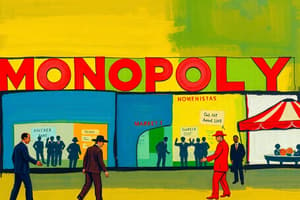Podcast
Questions and Answers
Which characteristic is NOT typical of a monopoly market structure?
Which characteristic is NOT typical of a monopoly market structure?
- A single seller dominating the market.
- A standardized product with many close substitutes. (correct)
- Significant barriers preventing new firms from entering.
- The firm operating as a price maker.
What is the primary implication of economies of scale for a firm attempting to enter a monopolized industry?
What is the primary implication of economies of scale for a firm attempting to enter a monopolized industry?
- New firms can easily achieve profitability even at small production volumes.
- New firms must start at a large scale, which can be difficult and costly. (correct)
- Economies of scale make it easier for new firms to compete immediately.
- Economies of scale are irrelevant to new firms entering the market.
How does the control of essential raw materials act as a barrier to entry in a monopolistic market?
How does the control of essential raw materials act as a barrier to entry in a monopolistic market?
- It has no impact on potential competitors.
- It prevents potential rivals from accessing the necessary resources for production. (correct)
- It encourages new firms to find alternative materials, increasing competition.
- It allows the monopolist to increase its market share through aggressive advertising.
In what way do patents primarily contribute to the establishment or maintenance of a monopoly?
In what way do patents primarily contribute to the establishment or maintenance of a monopoly?
Which statement accurately describes how copyrights support a monopoly in specific markets?
Which statement accurately describes how copyrights support a monopoly in specific markets?
What is the shape of the demand curve faced by a monopolistic firm, and why?
What is the shape of the demand curve faced by a monopolistic firm, and why?
In what scenario would a monopolist likely choose to lower the price of their product?
In what scenario would a monopolist likely choose to lower the price of their product?
How might a government-issued license lead to a monopolistic market structure?
How might a government-issued license lead to a monopolistic market structure?
A local water company operates as a monopoly because it has exclusive rights to the only water source in the region. Which barrier to entry does this best exemplify?
A local water company operates as a monopoly because it has exclusive rights to the only water source in the region. Which barrier to entry does this best exemplify?
A pharmaceutical company discovers a new drug and obtains a patent for it. What implications does this have for the market of this new drug?
A pharmaceutical company discovers a new drug and obtains a patent for it. What implications does this have for the market of this new drug?
Flashcards
Monopoly Definition
Monopoly Definition
A market with a single seller and many buyers.
Unique Product
Unique Product
The product offered is unique with no close alternatives available to consumers.
Price Maker
Price Maker
A firm that can influence the market price by controlling the quantity supplied.
Barriers to Entry
Barriers to Entry
Signup and view all the flashcards
Economies of Scale
Economies of Scale
Signup and view all the flashcards
Resource Control
Resource Control
Signup and view all the flashcards
Licenses
Licenses
Signup and view all the flashcards
Patents
Patents
Signup and view all the flashcards
Copyright
Copyright
Signup and view all the flashcards
Monopoly Demand Curve
Monopoly Demand Curve
Signup and view all the flashcards
Study Notes
Monopoly Characteristics
- A monopoly consists of a single seller and a large number of buyers.
- The product offered is unique with no close substitutes.
- Monopolies are price makers.
- Entry to the market is blocked.
- Minimum advertising is needed.
Barriers to Entry
- Barriers prevent firms or sellers from entering the industry.
- A weaker barrier may allow a few firms to enter, creating an oligopoly.
Types of Barriers to Entry
- Economies of scale occur when average cost decreases as production expands.
- In a monopoly, new firms find it impossible to enter due to economies of scale.
- Monopolies are protected from competition.
- New firms need a large scale operation to enter, which is difficult.
- Small scale producers can hardly achieve normal profits and will eventually fail.
- A monopolist controls ownership of raw materials, preventing rivals.
- A sugar producer in Malaysia controls resources, making new entry nearly impossible.
- The government restricts new firms by imposing legal licenses.
- Licenses on television stations prevent new firms from entering and encourage monopolies.
- Patents give an inventor the exclusive right to use their invention.
- Patent laws prevent competitors and provide a monopoly power for the life of the patent.
- Copyright prevents potential rivals from copying products.
- Copyright gives exclusive rights to the books' author, music composer, film producer, etc.
Monopoly Demand Curve
- The main difference between a competitive firm and a monopolist is on the demand side.
- The demand curve for a monopoly is downward sloping by the law of demand.
- Monopolies set prices based on the elasticity of demand and its relation to total revenue.
- The marginal revenue curve lies below the demand curve.
- When marginal revenue is positive (MR<0), demand is inelastic.
- When demand is inelastic, as price increases, total revenue will increase.
- Total revenue is unchanged by price changes when demand is unitary elastic, where marginal revenue is zero (MR=0).
Monopoly Short Run Equilibrium (Profit Maximisation)
- Short run profit maximisation for a firm occurs in the monopoly market.
- The vertical distance between total revenue and total cost reflects total profit.
- The difference between total revenue and total cost is highest with 3 units.
- This provides a maximum profit of USD 160.
- Also, the area shows that the firm has experienced equilibrium in the short run.
- The average revenue and demand curve of a monopoly is downward sloping.
- The marginal revenue curve lies below the average revenue curve.
- The firm achieves equilibrium and maximum profit with marginal revenue equals marginal cost.
- This appears at the intersection point between marginal revenue and marginal cost at point E*.
- The profit-maximising price occurs at P*.
Short Run Profit Types in Monopoly
- Monopolies earn supernormal or economic profits where average revenue is greater than average cost.
- Equilibrium happens when marginal revenue equals marginal cost at E*.
- The profit maximising quantity is at Q where the monopolist charges the price at A.
- The shaded area ACDB represents supernormal profit.
- Monopolists have subnormal or negative profits, or losses, when average revenue is less than average cost at point E*.
- Profit maximising output is obtained at Q and where the profit-maximising price is at B.
- Subnormal profit the monopolist makes appears in the shaded area ADCB.
- At the equilibrium point where marginal revenue equals marginal cost, a monopolist can break even.
- The profit-maximising output and price are at Q and A respectively when marginal revenue equals marginal cost.
- Average revenue equals average cost, and the monopolist earns normal profit.
Monopoly Long Run Equilibrium
- The long run follows the same rule as the short run where marginal revenue equals marginal cost.
- Monopolists earn supernormal profit because of barriers to entry.
- With no competition, monopolies can increase or decrease prices based on cost.
- A monopolist may increase its price to avoid minimum profit or losses if production costs increase.
- Long run equilibrium is achieved when long run marginal revenue equals long run marginal cost at point E*.
- Profit-maximising price is at point A, profit-maximising output at point Q.
- Barriers to entry mean that the monopolist earns supernormal profit in the long run, shown by area ACBD.
Studying That Suits You
Use AI to generate personalized quizzes and flashcards to suit your learning preferences.




